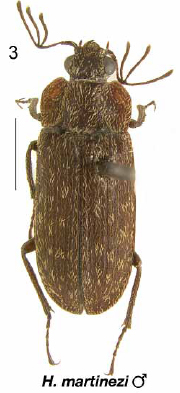| .. |
Scarabaeoidea of Southern South America Links
|
.
|
|
| |
| .. |
Scarab Guide Links
(goes to the University of Nebraska
web site) |
.
Classification |
Superfamily...
Family...........
Subfamily .....
Tribe............
|
Scarabaeoidea
Lucanidae
Aesalinae
Ceratognathini |
|
|
| |
|
| . |
.
Hilophyllus martinezi Paulsen & Mondaca, 2006
Hilophyllus martinezi Paulsen & Mondaca, 2006: 16. |
| |

|
Hilophyllus martinezi Paulsen & Mondaca. |
| |
|
Figure 21. Ventral view of male genitalia, H. martinezi. |
| |
| |
|
Figure 25. Localities from which Hilophyllus specimens were examined: H. penai (asterisks), H.
argentinensis (squares), and H. martinezi (triangle). |
| |
|
...... |
Description. Holotype male. Length: 8.0 mm. Width: 2.9 mm. Color/Surface: Dark reddishbrown,
weakly shining. Dorsum almost uniformly covered with large punctures,
most with a single elongate, apically acute scale. Head: Eyes large, width of
eyes together in dorsal view greater than narrowest interocular width. Mandibles small,
externally rounded, not abruptly curved inward at middle; dorsal tooth acute; ventral tooth
of right mandible minute (apex of right mandible broken). Antennal club segments
elongate, longer than 1.5 times length of head. Pronotum: Sides strongly
explanate, explanate margin subequal to eye in width. Anterior angle produced beyond
anterior margin. Lateral margin broadly rounded, widest before middle. Elytra:
Shape elongate. Almost uniformly punctate, most punctures with scales, punctures
without scales forming longitudinal rows (not patches), scales brown and testaceous.
Sutural interval and lateral margin elevated apically. Surface between punctures
roughened, appearing wrinkled at 40x. Legs: Mesotibiae lacking external tooth.
Male genitalia: See Fig. 21. Parameres with 2 small, external teeth at apex,
median lobe cylindrical toward apex, not laterally compressed.
Female unknown. |
| |
|
| |
Diagnosis.
This species is distinguished from H. penai by its unarmed mesotibiae. It is, however,
externally quite similar to H. argentinensis. The most notable external difference between
these two species is in the anterior angles of the pronotum, which are produced beyond the
anterior pronotal margin in H. martinezi but more or less contiguous with the anterior
margin of the pronotum in H. argentinensis. This gives the overall impression of
a smaller pronotum in H. martinezi. Ideally we would prefer more material upon which to
base a new species. However, the form of the male genitalia in H.
argentinensis and H. martinezi are vastly different. Based on the constancy of male
genitalic form (i.e., lack of variation) observed in H. penai (n = 4), as well as in H.
argentinensis (n = 9) across its range, we believe that the unique male genitalic form of H.
martinezi is compelling evidence that this is a distinct species. |
| ...... |
|
| |
Distribution. CHILE. The species is known from central Chile. |
| |
|
| Locality data: 1 specimen examined.
CHILE (1). VIII Región (1): Los Lleuques.
Temporal distribution. November (1). |
| |
|
Etymology.
The species is named martinezi in honor of Antonio Martínez and his contributions to
the knowledge of South American Coleoptera. |
| |
|
|
Remarks.
This single specimen from Los Lleuques, Ñuble, is similar externally to H.
argentinensis. However, the male genitalia are distinct. The apex of each
paramere bears two minute, external teeth rather than the large external tooth
present on H. argentinensis. Furthermore, the parameres are strongly narrowed before the
apex and the median lobe is broad and subcylindrical to the apex, not strongly laterally
compressed. Nothing is known about the biology of this species. |
| |
|
| |
Excerpt from:
Paulsen, M. J. & J. Mondaca E. 2006. Revision of the South American Ceratognathini (Coleoptera:
Lucanidae: Aesalinae) with the description of a new genus and
a new species. Zootaxa 1191: 1–19. |
| |
|

